Searching for peril beneath the pristine
by Tracy Kalytiak |
Erin Smith's father taught her how to trade in the stock market, so, as a high-schooler, she set a goal of becoming a financial advisor. Smith earned bachelor's degrees in management and finance, minoring in economics, and went to work. She became a credit analyst and then a pension representative. But, something just didn't feel right about her career choice.
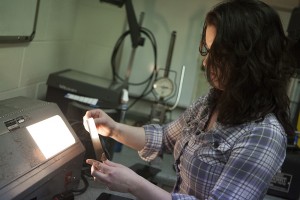
Erin Smith explains radiographic testing during a nondestructive testing class she is taking as part of an Alaska Department of Labor and Workforce Development grant program. (Photo by Philip Hall/University of Alaska Anchorage)
"It got to the point where I was tired of the industry, tired of pushing paperwork," she said. "I remember looking out at the mountains and thinking, 'What am I doing with my life-there's more to this than being chained to that desk.' I wanted to get myself out in the dirt, out in the world. I wanted to not only use my mind, but my physicality."
Smith had earned her degrees at UAA, so she looked at UAA's website and narrowed down trade options she wanted to explore: welding and getting into the aviation industry. The administrative assistant for the UAA Community & Technical College's welding program suggested the nondestructive testing occupational endorsement certificate (OEC), and the idea of hands-on training in various technologies sparked Smith's imagination.
"It's a perfect match," Smith said. "I'm very analytical, logical. I see patterns, know when things look right and don't look right. I have a very curious mind. It's stimulating, I would always be learning something, it would never get boring."
Finding faults
As bridges, engines and other machines and structures age, the need to repair them becomes inevitable. They can crack, grow porous, weaken. Problems can exist even in new structures, if key parts are joined together with flawed welds that could snap apart. People could lose their lives if a bridge, crane or engine part fails.
Usually dangers lurk out of sight, under what appears to be a flawless veneer.
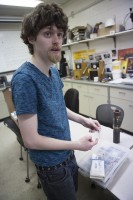
Daniel Carrick shows equipment used in radiographic materials testing, during an NDT class at UAA. (Photo by Philip Hall/University of Alaska Anchorage)
How do engineers determine where flaws exist-and the extent of those flaws-if they're not apparent to the naked eye?
Nondestructive testing evaluates materials, components or structures to reveal defects in, say, a bridge, engine, weld or tank without causing damage. Tests involve a variety of techniques: dye penetrant highlights surface-breaking flaws; magnetized particles reveal subsurface cracks in metal; ultrasonic testing uses sound waves to detect delaminations and flaws deep inside a part; and radiographic testing uses X-rays and other forms of radiation to reveal faulty welds.
NDT is a high-demand job field in Alaska, and companies frequently hire technicians from out of state to fulfill that demand.
The oil and gas industry and UAA have partnered to enhance training for current or prospective NDT workers, with help from the Alaska Department of Labor and Workforce Development. Last fall, the labor department granted Alaska Oil and Gas Training Fund dollars to UAA's NDT program to cover the cost of student tuition, fees, books and equipment leading to 12 eligible students earning an OEC.
Smith is one of those eligible students. She's working toward certification in nondestructive testing. "I have a passion for [NDT] and know it will not only save people's lives, it will save people money in the long run," Smith said.
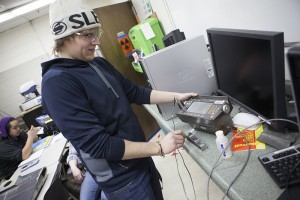
Kyle Fetters uses an ultrasonic testing tool during an NDT class. (Photo by Philip Hall/University of Alaska Anchorage)
Four of the students in Smith's class already have jobs through that grant program, on the North Slope with Kakivik Asset Management, but return during their two-weeks-off periods to continue studying in UAA's NDT program.
"Kakivik had an immediate need for trained and qualified NDE (nondestructive testing examiner) personnel for emerging work on the North Slope," said Ian B. Moreau, a training and certification manager for Kakivik. "Through this grant we were able to provide a shortened 'pipeline' through which the students gain their immediate training and skills needed for employment in the NDE industry."
UAA and Kakivik, Moreau said, are using the grant program to explore collaborative efforts to provide the students with not only the training necessary but the on-the-job experience that is also a necessary component to the final qualification and certification process for the NDE industry.
Typically, an NDE student will complete NDE training through UAA and then still have to complete more than 1,000 hours of on-the-job training before becoming certified, Moreau said.
"With this current program, several students have been hired by Kakivik and are concurrently gaining [on-the-job] hours while completing their UAA coursework," he said.
Setting a course
Blaise Bucsko found out about the NDT program through the Bristol Bay Native Corp. website. The 2011 alumnus was guiding rafts and making beer professionally when he decided he needed a career he could count on, so he enrolled at UAA the following semester.
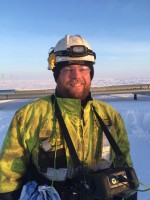
Blaise Bucsko, a UAA NDT student, now works for Kakivik Asset Management, on the North Slope. (Photo courtesy of Blaise Bucsko)
His reasons for choosing NDT?
"Longevity in the industry," he said. "You work smarter rather than harder. Less wear and tear on the body."
He also liked the pay, potential for jobs worldwide and a schedule that has him working for three weeks and home for three weeks.
"I desired the schedule more than anything else," he said.
His instructor, Eli Van Ringelenstein, taught him the ultrasonic, radiographic, penetrant and magnetic inspection methods. Bucsko went on to take American Petroleum Institute exams to receive certifications in pipeline and above-ground storage tank inspection.
"Mr. Van Ringelenstein was excellent at relating real-world scenarios to the classroom," Bucsko said of his NDT training. "I felt more than adequately prepared to step into a job and use my skills learned at UAA."
Daniel Carrick was involved in UAA's automotive program, studying to become a mechanic, when he decided to move into welding. For mechanics, "knowing how to weld is a good thing," he said. "I just wasn't really enjoying working in a shop environment. I wanted to do something else."
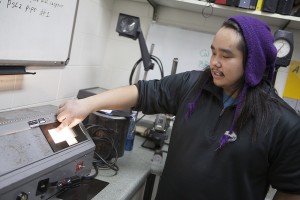
Trenton Coopchiak shows a slide of a step calibration during one of his NDT classes. (Photo by Philip Hall/University of Alaska Anchorage)
Carrick entered the Welding & Nondestructive Testing Technology associate degree program. The day classes started, administrative assistant Christine VanValkenburgh told him about the first-come, first-served Department of Labor NDT grant. The NDT OEC is one of three that make up the core curriculum for the associate degree program Carrick had entered. The certificates flow seamlessly into the associate degree without duplicating coursework.
He turned in his application within 45 minutes.
"I got lucky," he said. "I ended up dropping every single class the next day and signing up for an entirely new thing."
Trenton Coopchiak had just arrived at UAA and was about to start in UAA's welding program when he, too, spoke with VanValkenburgh.
"She said I'd qualify for the grant program," he said. "I dropped all the classes I was going to take. I'd like to work for Kakivik because it's a Bristol Bay subsidiary. That's my corporation and I would just like to help contribute to that."
Written by Tracy Kalytiak, UAA Office of University Advancement
 "Searching for peril beneath the pristine" is licensed under a Creative Commons Attribution-NonCommercial 4.0 International License.
"Searching for peril beneath the pristine" is licensed under a Creative Commons Attribution-NonCommercial 4.0 International License.














